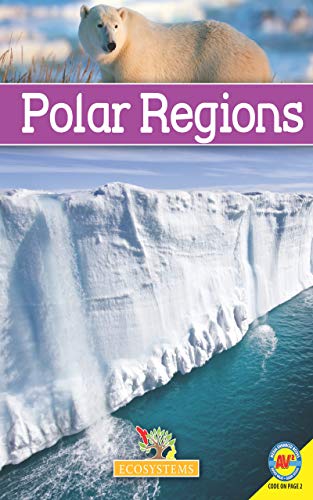-
Polar Regions
Melanie Waldron
Paperback (Raintree, Aug. 1, 2012)This book explores polar habitats around the world, looking at the plants and animals that live there, and the adaptations that help them to survive. Food webs, maps, and photos help bring the topic to life. Threats to polar habitats are also covered, as well as efforts to preserve them. P
P
-
Polar Regions
Simon Rose
language (AV2 by Weigl, Feb. 18, 2019)Polar regions are the areas close to Earth’s two poles. Penguins can only be found in the southern polar region. Learn more in Polar Regions. Polar regions is an AV2 media enhanced book. A unique book code printed on page 2 unlocks multimedia content. This book comes alive with video, audio, weblinks, slideshows, activities, hands-on experiments, and much more!
-
Polar Regions
W. Nigel Bonner, Nigel Bonner
Library Binding (Thomson Learning, Aug. 1, 1995)Describes the characteristics of the two poles, the plant and animal life that exists in the polar regions, minerals and other natural resources, the peoples of the Far North, living in Antarctica, polar exploration, and the efforts to protect these unique environments R
R
-
The Polar Regions
Mel Higginson
Library Binding (Rourke Pub Group, Sept. 1, 1994)- R
R
-
The Polar Regions
David Rootes
Library Binding (Chelsea House Pub, Sept. 1, 2000)Recounts the early exploration of the North and South Poles, and looks at the modern utilization of the polar regions. U
U
-
The Polar Regions
Mason Crest
Library Binding (Mason Crest, Jan. 1, 2016)At the top and bottom of the world are enormous areas of . . . nothing. Virtually no life exists in the frozen wastelands of the North and South Poles. However, the human spirit of adventure and discoveryto say nothing of the desire to tap into natural resourcesled people to try and conquer the icy lands. Inside, read about the courageous and daring explorers who first opened up the poles to scientific discovery. Then see how the worlds nations have worked together not only to find out more about the polar regions, but to work together to protect them. U
U
-
Polar Regions
Melanie Waldron
Hardcover (Raintree, Sept. 10, 2012)This volume explores Polar habitats around the world, looking at the plants and animals that live there, and the adaptations that help them to survive. Food webs, maps, and photos help bring the topic to life. R
R
-
Polar Regions
Sally St. John
Paperback (n/a, March 15, 2010)Great teaching book for kids. Teach your child all about polar regions and the animals all around! G
G
-
Polar Regions
Melanie Waldron
Library Binding (Raintree, Aug. 1, 2012)This book explores polar habitats around the world, looking at the plants and animals that live there, and the adaptations that help them to survive. Food webs, maps, and photos help bring the topic to life. Threats to polar habitats are also covered, as well as efforts to preserve them. P
P
-
Polar Regions
Samantha Nugent
Paperback (Let's Read, July 1, 2016)Exploring Ecosystems examines the relationship between living things and their environment. Young readers will learn about the different plants, animals, and climates that make up our planet. This visually stimulating series will also help readers understand why it is important to protect the worlds ecosystems. M
M
-
Polar Regions
James Kerr
Paperback (Heinemann, Aug. 15, 2016)Where does the sun continually shine, even at night? How do penguins keep their eggs warm? How can there be deserts in the coldest places on Earth? This title unlocks the mysteries of the Arctic and Antarctic regions. It looks at expeditions to the North and South Poles--from the earliest adventurers to modern tourist cruise--and investigates how people and animals survive on these frozen frontiers.
-
Polar Regions
Samantha Nugent
Library Binding (Let's Read, July 1, 2016)Exploring Ecosystems examines the relationship between living things and their environment. Young readers will learn about the different plants, animals, and climates that make up our planet. This visually stimulating series will also help readers understand why it is important to protect the worlds ecosystems. M
M